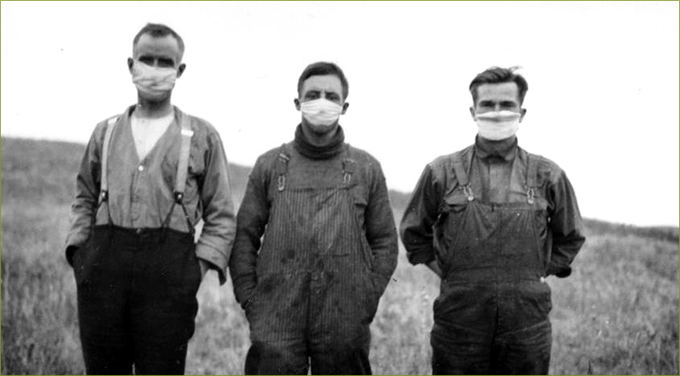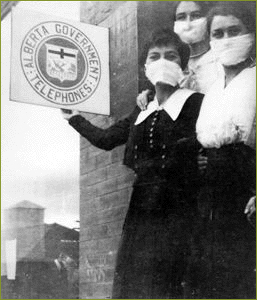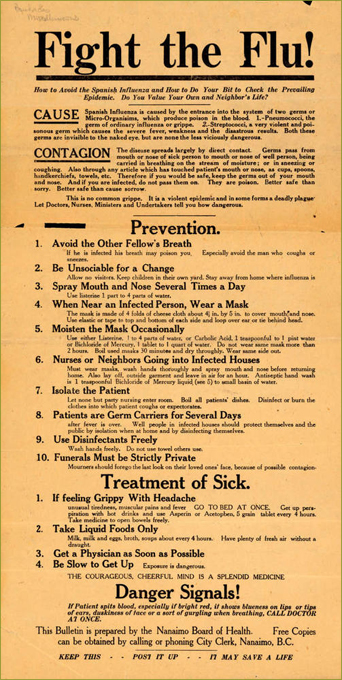

Pandemic History in Canada
BY: BG EDITOR

Protecting against the flu
[ Image: Library and Archives Canada #PA-025025 ]
Mar 14, 2020 — GREENWOOD, BC (BG)
The COVID-19 virus is now dominating the news, and confounding many hearts and minds. It seems fitting that we offer a brief, albeit grim historical overview in today's feature.
There were two major pandemics experienced by the residents of early Greenwood. One happened just before, and the other just after the dates of our archive of local historical newspapers, so little information is readily available about the impact here in Greenwood. However, the history of both pandemics in British Columbia are well documented:[1]
1889-90 — The Russian Flu
"The first significant flu pandemic started in Siberia and Kazakhstan, traveled to Moscow, and made its way into Finland and then Poland, where it moved into the rest of Europe. By the following year, it had crossed the ocean into North America and Africa. By the end of 1890, 360,000 had died."
1918-19 — Spanish Flu
"The avian-borne flu that resulted in 50 million deaths worldwide, the Spanish flu is theorized to have originated in China and been spread by Chinese laborers being transported by rail across Canada on their way to Europe. In North America, the flu first appeared in Kansas in early 1918 and was visible in Europe by spring. Wire service reports of a flu outbreak in Madrid in the spring of 1918 led to the pandemic being called the "Spanish flu."
By October, hundreds of thousands of Americans died and body storage scarcity hit crisis level. But the flu threat disappeared in the summer of 1919 when most of the infected had either developed immunities or died."
By October, hundreds of thousands of Americans died and body storage scarcity hit crisis level. But the flu threat disappeared in the summer of 1919 when most of the infected had either developed immunities or died."
The history of pandemic flu in Canada covers five major outbreaks:[2]
"Canada has experienced five influenza pandemics since the late 19th century, in 1890, 1918, 1957, 1968 and 2009. In Canada, influenza causes an estimated 12,200 hospitalizations and 3,500 deaths each year. ...
In Canada, influenza appeared in epidemic proportions on several occasions prior to the 20th century, particularly among Indigenous communities who had no immunity to the disease. Influenza epidemics often occurred during outbreaks of other diseases, including the 1847 Typhus epidemic in Montreal and a 1900 epidemic of measles and influenza that began in Alaska and spread into the Yukon.
In terms of influenza pandemics, experts believe that there have been about 14 since 1500, some of which spread to North America. Since Confederation, five pandemics have affected Canada: the 1890 Russian flu, the 1918 Spanish flu, the 1957 Asian flu, the 1968 Hong Kong flu and the 2009 H1N1 pandemic.
1890: Russian or Asiatic Flu in Canada
"The Russian or Asiatic flu (likely caused by an H3Nx virus) began in the Eurasian Steppes, spread across Russia and Europe and arrived in northeastern North America in December 1889. By 1890, it had reached Canada, including the cities of Montreal, Toronto, Hamilton, Ottawa, London, Winnipeg and Vancouver. Although less lethal than the 1918 Spanish flu, some experts believe that exposure to the 1890 flu made patients more susceptible to severe outcomes (including death) during the 1918 pandemic.The theory centres on the concept of "original antigenic sin," which suggests that for rapidly changing viruses such as influenza, the body may rely on antibodies developed in response to an earlier strain, thus compromising its response to the new virus.

A group of nurses in High River, Alberta, wear face masks
in an attempt to ward off the Spanish Flu, October 1919
[ Image: Glenbow/NA 3452-2 ]
1918: Spanish Flu in Canada
"The most damaging epidemic of influenza — for Canada and the world — appeared during the First World War. The Spanish flu of 1918-19 killed between 20 and 100 million people, including about 30,000-50,000 Canadians. Unlike most strains of influenza, which are dangerous for those with reduced immunity (e.g., the elderly, the very young and those with pre-existing conditions), the 1918 Spanish flu tended to kill the young and hearty. Pneumonia contracted by a patient weakened by influenza rather than influenza itself was the major cause of death. A long-term consequence for some victims was the development of a parkinsonian syndrome, including a marked tremor.
The Spanish flu was brought into Canada by returning troops and made its way into even the remotest communities. Some entire villages were wiped out by the disease, and Labrador and Quebec were particularly hard hit. Some areas unsuccessfully tried quarantine. All medical facilities and personnel were soon overtaxed and volunteers organized infirmaries in schools and hotels.
The epidemic brought not only death but social and economic disruption as well. Children were left parentless and many families found themselves without their chief wage earner. Armies on both sides of the war were temporarily debilitated. Businesses lost profits because of lack of demand for their products or because they were unable — as a result of a reduced work force — to meet the demand. Municipal governments, in an attempt to halt the spread of the disease, closed all except necessary services, and provinces enacted laws regarding quarantine and enforced the wearing of masks in public. Although the Canadian population unhappily accepted these restrictions, it defied the federal government's request that First World War victory celebrations be postponed until 1 December. The establishment of the federal Department of Health in 1919 was a direct result of the epidemic.
The Spanish influenza strain, although decreasingly virulent, remained active in Canada until the mid-1920s. It has since been identified as an H1N1 virus."
In 2018, British Columbia observed the 100th anniversary of the Spanish Flu pandemic:[3]
"Harry Peuch died on October 10, 1918 at St. Paul's Hospital in Vancouver. Harry's death made the newspapers at the time because he was the first person in Vancouver to die from the Spanish flu. By October 18 of that same year there were an estimated 900 cases and 32 deaths in the city. October 1918 was when Vancouver (and the rest of BC) was hit hardest by the epidemic.
Soldiers returning from World War I on trains from eastern Canada unwittingly helped spread the virus to BC where it thrived in logging camps and First Nations communities as well as towns and cities. The Spanish flu was a strain of H1N1 virus and is estimated to have killed 50 - 100 million people worldwide.
The virus was deadly for otherwise healthy people with strong immune systems. Most of the deaths were among those aged 20 to 40 years. The virus worked so quickly that its victims could be seemingly healthy in the afternoon and dead by the next day. The respiratory distress was so sudden and severe that victims often suffocated in their own respiratory secretions."
Soldiers returning from World War I on trains from eastern Canada unwittingly helped spread the virus to BC where it thrived in logging camps and First Nations communities as well as towns and cities. The Spanish flu was a strain of H1N1 virus and is estimated to have killed 50 - 100 million people worldwide.
The virus was deadly for otherwise healthy people with strong immune systems. Most of the deaths were among those aged 20 to 40 years. The virus worked so quickly that its victims could be seemingly healthy in the afternoon and dead by the next day. The respiratory distress was so sudden and severe that victims often suffocated in their own respiratory secretions."

Staff prepare a bed at Vancouver General Hospital, c. 1919
[ Image: Library and Archives Canada ]
When Martin Luther was dealing with the Black Death plague, he offered the following wisdom to a friend:
"I shall ask God mercifully to protect us. Then I shall fumigate, help purify the air, administer medicine and take it. I shall avoid places and persons where my presence is not needed in order not to become contaminated and thus perchance inflict and pollute others and so cause their death as a result of my negligence. If God should wish to take me, he will surely find me and I have done what he has expected of me and so I am not responsible for either my own death or the death of others. If my neighbor needs me however I shall not avoid place or person but will go freely as stated above. See this is such a God-fearing faith because it is neither brash no foolhardy and does not tempt God."
Luther's Works, Volume 43, pg 132 -- The letter, "Whether one may flee from a Deadly Plague", written by Martin Luther to Rev. Dr. John Hess
Luther's Works, Volume 43, pg 132 -- The letter, "Whether one may flee from a Deadly Plague", written by Martin Luther to Rev. Dr. John Hess
We offer our best wishes for the good health and well being of all our Beautiful Greenwood readers, wherever you may be. Please extend a helping hand to the most vulnerable in your communities, and Godspeed through whatever lies ahead.
FOOTNOTES:
[1] Historical Flu Pandemics
https://www.history.com/topics/middle-ages/pandemics-timeline
[2] Influenze Pandemics
https://www.thecanadianencyclopedia.ca/en/article/influenza
[3] "100 years since BC slammed by Spanish Flu pandemic"
http://www.vch.ca/about-us/news/100-years-since-bc-slammed-by-spanish-flu-pandemic



